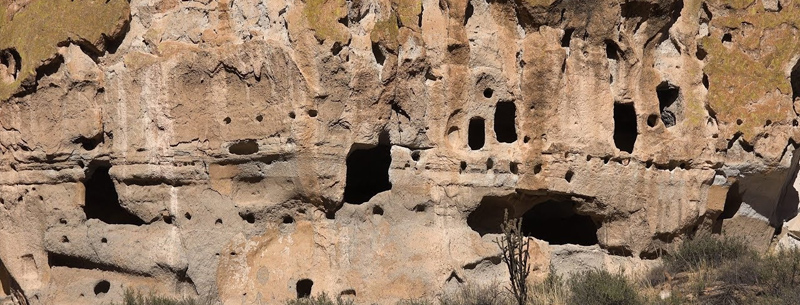Located in north-central New Mexico, Bandelier National Monument’s 32,737 acres encompasses a spectacular array of archeological, historic, and natural features. Today, 10,000 years after its first visitors appeared, Bandelier attracts more than 300,000 people each year.
“It is the grandest thing I ever saw,” proclaimed Adolph F. Bandelier as he stood at the rim of Frijoles (free-HOH-lace) Canyon in 1880. The grand thing to which he referred was the remains of dwellings of the area’s earlier inhabitants, the Ancestral Pueblo people. Today, you can visit these dwellings and the descendants of the Pueblo. Frijoles Canyon is the best area to experience the prehistoric sites up close and personal.
Since the designation of two-thirds of the park as a wilderness area nearly 30 years ago, visitors increasingly come for the joy of experiencing natural beauty and solitude in this pristine environment. The range of elevations in Bandelier provides habitat for a variety of birds and animals and hundreds of species of native plants. Depending on fortune, season, and time of day, one might see anything from a wild rose to a black bear, a tarantula hawk wasp, a canyon wren, or elk. Traces of the Ancestral Pueblo people are everywhere, including petroglyphs, crumbled structures, and bits of broken pottery.
Bandelier Trivia
- In 1880, forty-year-old Adolph Francis Bandelier came to fulfill a life-long dream of exploring the ancient sites of the Pueblo people. He was the first to study and report on the Ancestral Pueblo dwellings in Frijoles Canyon. In 1890, his novel, The Delight Makers, focused attention on the ancient people of the Pajarito Plateau. In 1916, the park was named for this extraordinary man.
- Bandelier National Monument contains approximately 23,000 acres of designated wilderness with more than 70 miles of hiking trails. Lush, narrow canyons alternate with sweeping mesa-top vistas in this challenging terrain. Elevations range from 5,000 to 10,000 feet.
- The geologic history of the Bandelier National Monument has its origins in the eruptions of an ancient volcano. Two major eruptions, approximately 1.6 and 1.2 million years ago, produced volumes of ash 600 times greater than the 1980 eruption of Washington’s Mount Saint Helens.
Bandelier Attractions
- Join a park ranger-guided walk along the Main Loop Trail behind the visitor center to Tyuonyi (chew-OHN-yee) Pueblo and visualize what life was like here 700 years ago.
- Follow the Falls Trail downstream from the visitor center, passing two waterfalls, and view unusual geologic features, including a maar volcano.
- Become enchanted by Bandelier’s popular “Nightwalk.” Once a week during the summer months, park rangers host the “Nightwalk,” a unique experience highlighting the cultural history of the Pueblo people.
- Enjoy expansive views of surrounding mountains and valleys from Tsankawi, a large unexcavated Ancestral Pueblo village located in a detached portion of the park, where you will also find numerous petroglyphs and cliffside homes.
- Take a self-guided walking tour of the Bandelier Historic District
- Gaze 1000 feet down White Rock Canyon at the flowing Rio Grande. From the canyon overlook platform, you can also look out over the vast panorama of the Jemez and Sangre de Cristo Mountains, the Española Valley, and the Caja del Rio.
